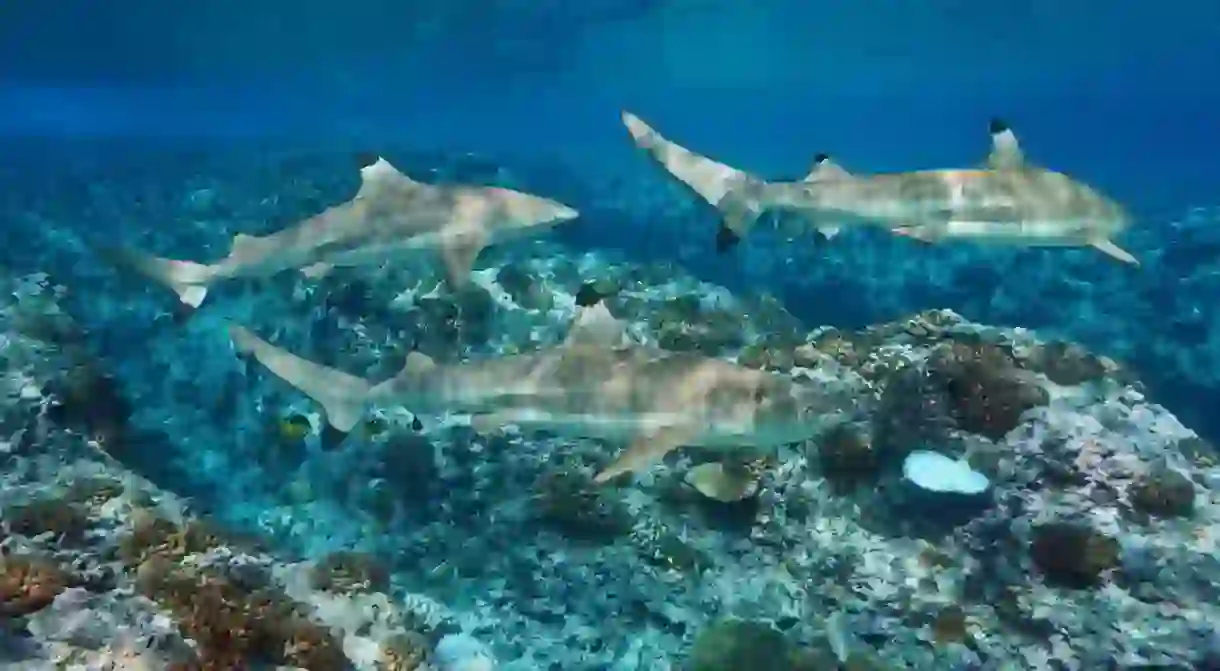Must-See Marine Life While Sailing Around Bora Bora, French Polynesia

Tear yourself away from the shoreline – the Listerine-blue lagoons surrounding the islands of Bora Bora are as spectacular as its white-sand beaches, towering mountains and low-lying atolls. Beneath the surface of the waves, you’ll find exceptional biodiversity, from luminous coral gardens to over 1,000 different species of fish. Read on to discover what animals to look out for while sailing and snorkelling in Bora Bora.
Hop aboard a fully skippered catamaran for an eight-day sailing adventure around French Polynesia with Culture Trip – no experience necessary.
Dolphins
Head to the bow, and look down. Friendly dolphins like to greet sailors as they traverse the depths and shallows of this corner of French Polynesia. Though the most well-known spot for catching a glimpse of these playful mammals is the waters around Rangiroa, you’ll spot them around all the islands of Bora Bora and wider French Polynesia year-round. Look out for bottlenose, spinner and rough-toothed dolphins.

Sharks
If you were wondering if there are sharks in Bora Bora, you should know that French Polynesia created the largest shark sanctuary in the world in late 2012, encompassing 1.5 million sqmi (3.9 million sqkm) of the Pacific Ocean. The 21 species that call these waters home are thriving as a result. Lemon, tiger, blacktip reef, hammerhead and mako sharks are among the species you’ll find in Bora Bora. Book an aqua safari to safely swim among them, while learning about local mythology; in Polynesian culture, sharks represent the souls of the ancestors.

Whales
Humpback whales return to the lagoons of the Society Islands, including Bora Bora, from July to October each year to give birth. You’ll spot them until as late as November, as they nurse in the sheltered lagoons before heading to the open ocean. Special tours offer the chance to snorkel alongside these 15m to 18m (50ft-60ft) giants. Be sure to book with a reputable company that observes local protections and Polynesian law regarding interactions with wildlife.
Rays
Another giant of the seas, the manta ray glides and darts through the water, flapping its pectoral fins as though performing an underwater ballet. In fact, rays visit Bora Bora’s lagoon daily to get a quick spruce from cleaner fish. The French Polynesia Manta Project has identified 137 individual reef manta rays in Bora Bora. You’ll also catch a glimpse of stingrays and eagle rays, too, if you’re lucky.

Turtles
The warm sands and deserted beaches make the islands of Bora Bora a prime spot for nesting turtles. Green turtles return to these shores every September to April to lay their eggs. Whilst there are a number of other species in these waters, the other you’re most likely to spot is the hawksbill, looking for sponges on the seabed. If you’re not lucky enough to catch a glimpse of them in the water, head to the Ecological Center at Le Méridien Bora Bora to watch the feeding of turtles in its care.

Tropical fish
With so much rare and protected wildlife in the waters of French Polynesia, it’s easy to overlook the many brightly coloured tropical fish that make snorkelling in Bora Bora so appealing. With schools of parrot, butterfly and trumpet fish darting through the sea fans, as well as grouper, damselfish and the unusually named zebra unicorn, you’ll be sure of a colourful display.

Coral
Multicoloured coral forms the centre of the delicate underwater ecosystem in the South Pacific; these islands and their wildlife would be nothing without the intricate reefs that support life here. The good news is that the reefs surrounding Bora Bora – principally cauliflower, elkhorn and finger corals – are in good health. Do your part by wearing reef-safe sunscreen in the water. Head to the coral garden near Matira Point, where on the east side of the beach you’ll find an area locals refer to as “the aquarium.”

Tips for responsibly spotting marine animals in Bora Bora
Remember, you’re stepping into the natural habitat of these wild animals. Be respectful – don’t crowd them or move towards them, as it might frighten them. Avoid touching them, even if they come close to you. Let the animal control the encounter. Check before you book with an activity provider that they follow sustainable practices, including not feeding the wildlife, and encourage travellers to do the same.













